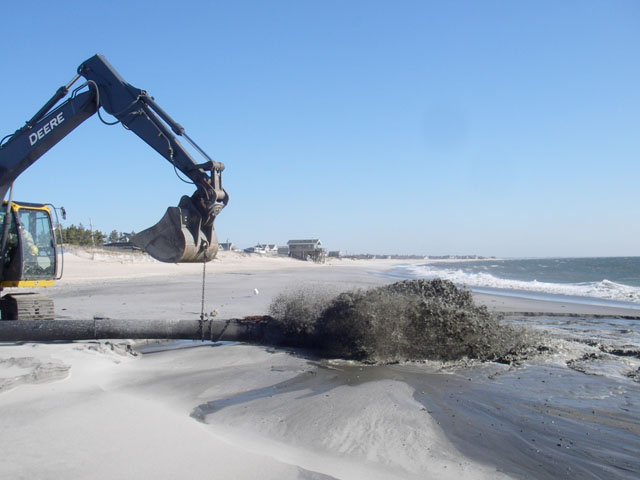
RI Coastal Resources Management Council
...to preserve, protect, develop, and restore coastal resources for all Rhode Islanders

...to preserve, protect, develop, and restore coastal resources for all Rhode Islanders
Ninigret dredging completed early, under budget
CHARLESTOWN, March 19, 2012 – Maintenance dredging of the sedimentation basin in Ninigret Pond in Charlestown has been completed under budget and sooner than projected. The work had been performed as part of the state’s maintenance of the pond under the South Coast Restoration project.
In cooperation with the Town of Charlestown, the R.I. Coastal Resources Management Council (CRMC) oversaw the dredging of the sedimentation basin in the pond, as well as the relief channel in the breach way and two additional bumps of material, totaling 80,000 cubic yards dredged. The sand was used to re-nourish Charlestown Town Beach. Work began in late January and ended a month later, earlier than the March 15 close of the dredge window. Originally, $1,029,000 in available funds had been allotted to the project (the state and town sharing the cost 70/30, respectively), but the project cost came in at just under $952,000.
The dredging was done to maintain flow and sedimentation to an area where eelgrass restoration done in previous years had been successful. Portions of the delta were previously dredged as part of the South Coast Restoration Project to create eelgrass habitat, and a sedimentation basin was created to prevent sediment from reaching the restoration areas and burying the restored eelgrass.
The project has been made possible because of financial contributions by the Town of Charlestown, which provided one-third of the projected cost. The State was able to pay the remainder by rearranging funds allocated for other portions of the South Coast project, which had been budgeted for maintenance purposes.
While the initial project was successful in restoring the eelgrass beds in a two-acre seeded section, as well as the remaining unseeded areas, sedimentation has occurred at a faster rate than anticipated. Because of this, the CRMC has had to adjust the maintenance dredging schedule from its original 10 years to three, and will dredge to eight feet below mean high water, prior to the first schedule dredge.
Sand dredged from the sedimentation basin was hydraulically deposited into the intertidal beach (just offshore) at Charlestown Town Beach, so that it will naturally wash ashore to create beach habitat used by Piping Plover and other important species. Eelgrass, an important native aquatic plant that grows in shallow sub-tidal areas, functions as a nursery, refuge and feeding ground for many marine species.
For more information on the South Coast Habitat Restoration project, go to http://www.crmc.ri.gov/habitatrestoration.html#southcoast.

Sand is hydraulically pumped from the pond directly onto the beach in Charlestown.